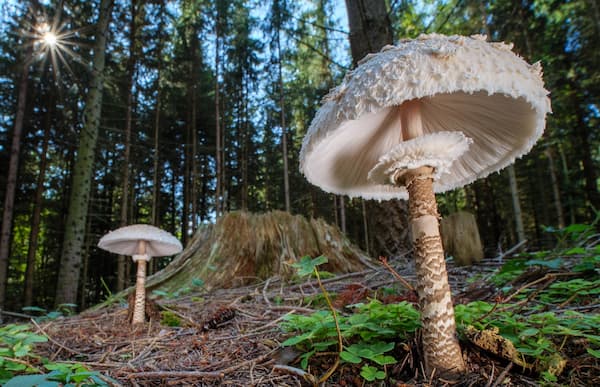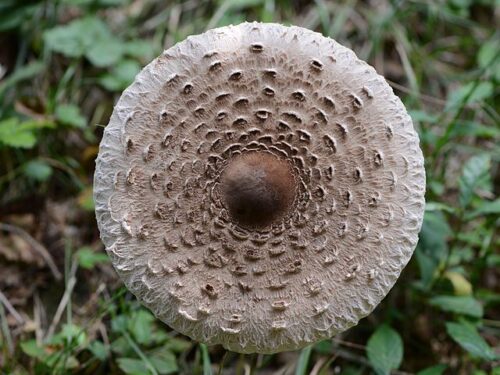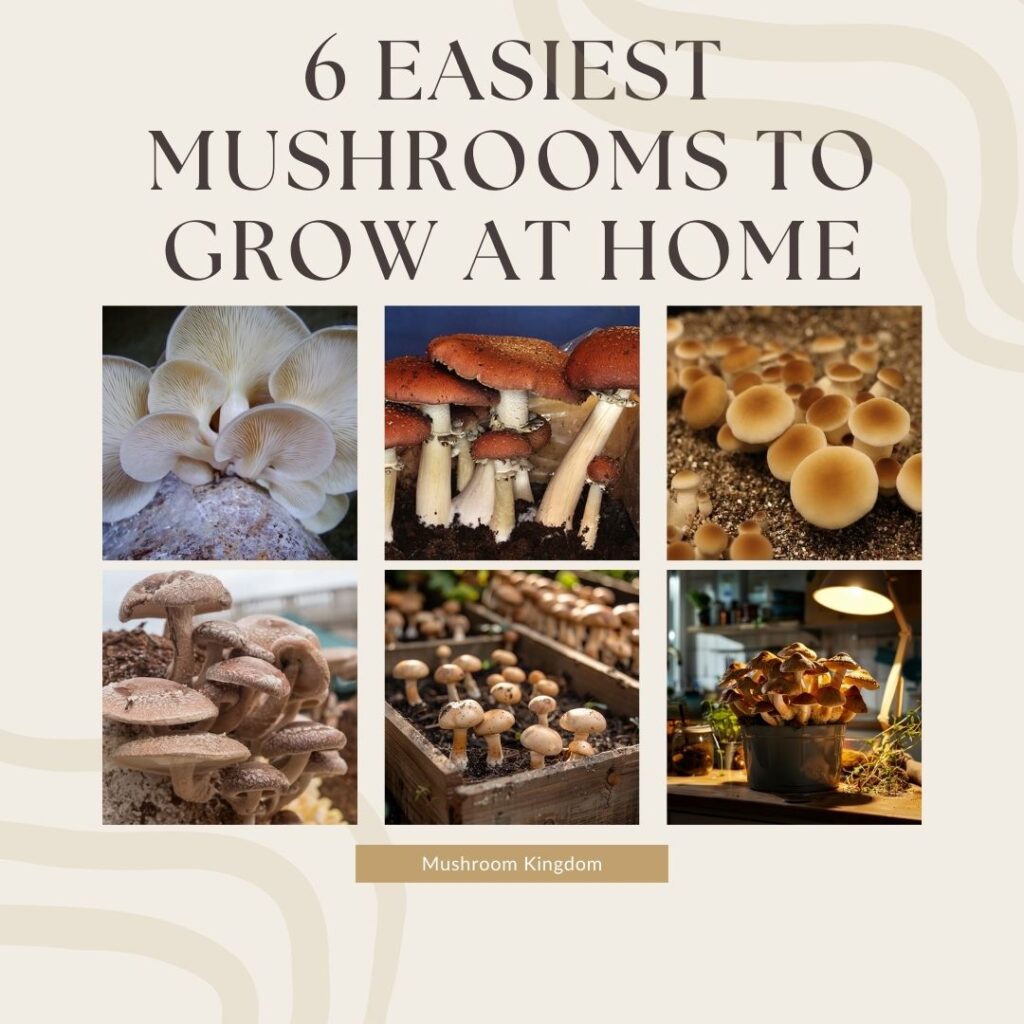Parasol mushrooms, known scientifically as Macrolepiota procera, are a delightful find for foragers due to their size and distinctive appearance.

Identifying Parasol Mushroom (Macrolepiota procera)
To correctly identify this mushroom, follow these detailed steps.
1. Examine the Cap
The cap of the parasol mushroom is quite large, typically measuring 10–30 cm in diameter. It starts out rounded but flattens with age, resembling a parasol or umbrella.

The cap’s surface is usually brown with a pattern of scales that appear more prominently towards the center. The edges of the cap often have a slight curve upwards, giving it a fringed appearance. As the mushroom matures, the cap opens fully and becomes more flat.
2. Check the Gills
Beneath the cap, you will find free, crowded gills that are white or creamy in color. These gills do not attach to the stem and should remain white or slightly off-white as the mushroom matures. Unlike some other mushrooms, the gills of the parasol mushroom do not change color significantly when bruised or damaged.
3. Observe the Stem
The stem of the parasol mushroom is tall and slender, ranging from 15–30 cm in height and 1–2 cm in width. A key identifying feature is the double ring, which can be moved up and down the stem. This ring is quite prominent and sturdy. The stem itself is brownish with a snakeskin-like pattern of scales, providing a unique texture that is easy to recognize.
4. Look at the Spores
Spore print color is another crucial identification marker. For the parasol mushroom, the spore print is white. To obtain a spore print, place a mature cap gills-down on a piece of white paper for several hours or overnight. The resulting print should be white. This spore print is an essential step in confirming the mushroom’s identity, as many mushrooms have different spore colors.
5. Check the Habitat
Parasol mushrooms commonly grow in grassy areas such as meadows, pastures, and woodland clearings. They thrive in well-drained soils and are often found in areas with decaying organic matter. They are typically found from late summer to autumn, often appearing after rain. Look for them in places that receive ample sunlight, as they do not typically grow in dense, shaded forests.
6. Smell and Taste
The parasol mushroom has a mild, nutty smell that is quite pleasant. If you choose to taste a small piece (and remember to always spit it out, never swallow), it should have a pleasant, mild flavor. This can be a useful characteristic to distinguish it from some poisonous look-alikes, which often have a bitter or unpleasant taste. However, always use multiple identification methods and do not rely solely on taste.
7. Consider Size and Scale Patterns
Larger size and the characteristic scaly patterns on both the cap and stem differentiate the parasol mushroom from similar species. Smaller, less scaly mushrooms might be look-alikes and should be approached with caution. The parasol mushroom’s size and distinctive patterns make it easier to identify compared to other mushrooms.
Are Parasol Mushrooms (Macrolepiota Procera) Edible?
Yes, parasol mushrooms (Macrolepiota procera) are edible and highly prized by foragers. These mushrooms are not only safe to eat but also considered delicious by many. Here are some reasons why you should consider adding parasol mushrooms to your culinary repertoire:
1. Flavor and Texture
Parasol mushrooms offer a mild, nutty flavor that complements various dishes. Their texture is firm yet tender, making them versatile in the kitchen. When cooked, they retain a pleasant chewiness, unlike some other mushrooms that can become slimy or mushy.
2. Nutritional Value
These mushrooms are low in calories but high in essential nutrients. They contain vitamins such as B-complex vitamins, vitamin D, and minerals like potassium, phosphorus, and zinc. Including parasol mushrooms in your diet can help enhance your nutritional intake without adding extra calories.
3. Culinary Uses
You can prepare parasol mushrooms in numerous ways. Sautéing them in butter or olive oil with garlic and herbs brings out their natural flavors. They can also be grilled, baked, or added to soups and stews. For a delightful twist, try breading and frying the caps to create a crispy, savory treat.
4. Safety Tips
Although parasol mushrooms are edible, proper identification is crucial to avoid confusion with toxic look-alikes such as the false parasol (Chlorophyllum molybdites).
Parasol Look-Alikes and False Parasol
When foraging for parasol mushrooms (Macrolepiota procera), it’s crucial to be aware of their look-alikes, particularly the false parasol (Chlorophyllum molybdites). Understanding these look-alikes helps prevent accidental consumption of toxic species. Here’s a detailed comparison to aid in proper identification.
1. False Parasol (Chlorophyllum molybdites)
Appearance: The false parasol, often found in lawns and grassy areas, closely resembles the parasol mushroom. It has a similar large cap with brownish scales and a tall, slender stem. However, there are distinct differences:
- Cap: The cap of the false parasol is slightly less scaly and can have a more irregular, uneven appearance.
- Gills: Initially white, the gills turn greenish as the mushroom matures.
- Spore Print: This is a crucial distinguishing feature. The false parasol produces a green spore print, whereas the parasol mushroom produces a white spore print.
- Ring: The ring on the stem of the false parasol is double-layered but often less pronounced and movable than that of the parasol mushroom.
Toxicity: The false parasol is toxic and can cause severe gastrointestinal distress, including nausea, vomiting, and diarrhea. Symptoms usually appear within a few hours of consumption.
2. Shaggy Parasol (Chlorophyllum rhacodes)
Appearance: The shaggy parasol also looks similar to the parasol mushroom, with some key differences:
- Cap: It has a scaly cap, but the scales are more uniformly distributed and can be more pronounced.
- Gills: The gills are white and free from the stem.
- Spore Print: White spore print, similar to the parasol mushroom.
- Stem: The stem is stout and has a double ring. However, when cut, the stem of the shaggy parasol may stain reddish-brown, which does not occur in the parasol mushroom.
Edibility: Shaggy parasols are generally considered edible, but some individuals may experience allergic reactions or gastrointestinal upset. Always cook them thoroughly and consume in small amounts initially to test for sensitivity.
Etymology of Macrolepiota procera
The scientific name Macrolepiota procera provides insight into both the physical characteristics and the taxonomy of the parasol mushroom. Let’s break down the etymology:
Genus: Macrolepiota
- Macro-: Derived from the Greek word “makros,” meaning “large” or “long.” This prefix highlights the large size of the parasol mushroom, especially its cap and stem, which are significantly larger than those of many other mushrooms.
- lepiota: This part comes from the Greek words “lepis” (meaning “scale”) and “ota” (a diminutive suffix), suggesting “small scales.” In the context of the genus, it refers to the scaly texture of the mushroom’s cap.
Thus, Macrolepiota essentially means “large-scaled,” accurately describing the prominent scaly appearance of the mushroom.
Species: procera
- Procera: The species name “procera” comes from the Latin word “procerus,” which means “tall” or “high.” This term is apt for the parasol mushroom, which is known for its tall, slender stem that can reach considerable heights compared to other mushrooms.
Combined Meaning
When combined, Macrolepiota procera translates to “tall large-scaled mushroom,” capturing the most notable features of the parasol mushroom: its impressive height and the distinctive scales on its cap. This etymology reflects both the physical appearance and the distinguishing characteristics that make the parasol mushroom a unique and easily recognizable species in the world of fungi.


